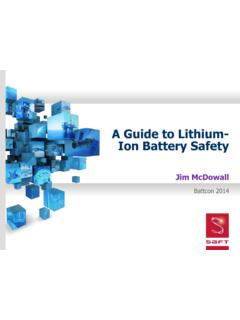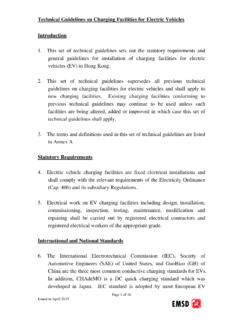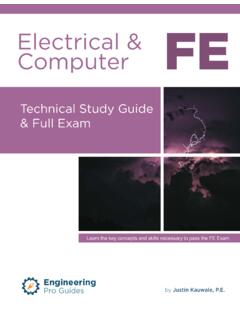Transcription of NFPA 855 UL9540 UL9540A - Institute of Electrical and ...
1 NFPA 855UL9540 UL9540 APopular View of the Evolution of the Electric Grid \ _( )_/ Whatever!2018 International Code Council Codes and NFPA 1 Fire CodeNew Chapter being approved for inclusion in the 2018 International Fire Code, Chapter 12 Energy SystemsA major change within this work was the introduction of array (unit) Stationary battery arrays. Storage batteries, prepackaged stationary storage batterysystems and pre-engineered stationary storage battery systems shall be segregated into stationarybattery arrays not exceeding 50 kWh (180 megajoules) each.
2 Each stationary battery array shall be spaced not less than 3 feet (914 mm) from other stationary battery arrays and from walls in the storage room or Battery chargers. Battery chargers shallbe compatible with the battery chemistry and the manufacturer selectrical ratings and charging chargers shall be listed and labeled in accordancewith UL Inverters. Inverters shall be listed andlabeled in accordance with UL 1741. Only inverterslisted and labeled for utility interactive system use andidentified as interactive shall be allowed to operate inparallel with the electric utility power system to supplypower to common DescriptionUL 9540 Standard for Energy Storage Systems and EquipmentUL 1642 Standard for Lithium Batteries (Cells)UL 1973 Standard for Batteries for Use in Light Electric Rail (LER)
3 Applications and Stationary ApplicationsUL 1741 Standard for Inverters, Converters, Controllers and Interconnection system Equipment for Use With Distributed Energy ResourcesUL 1564 Industrial Battery ChagersUL 1008 Standard for Transfer Switch EquipmentUL 3001 Outline for Investigation for Distributed Energy Generation and Storage SystemsUL 1778 Uninterruptible Power Supply SystemsApplicable UL StandardsUL 9540 compliant (Energy Storage system Listing) = including UL 1741 standard for inverters + UL 1973 standard for stationary batteriesIncreasing ESS compliance requirementsUL 95402017 NEC Sect.
4 706 NFPA 855UL 9540 ADeveloping IEC standardsIEC 62932 - FlowIEC 62933 - ESSR epurposing of batteries UL 1974 SCOPE OF NFPA 855 This standard establishes criteria for minimizing the hazards associated with energy storage systems (ESS).LI-ION BATTERIES ABNORMAL CHARGING8UL 9540A OverviewTest Method for Evaluating Thermal Runaway Fire Propagation in Battery Energy Storage SystemsUL 9540A is NOT a Standard but is currently referenced in NFPA 855 draftGoal is to provide quantitative data tocharacterize potential ESS fire eventsTesting is done at the cell, module, unit.
5 And possibly the installation levelExecution of this test method will be a significant undertakingThis will be referenced in UL 9540 in the futureUL 9540 addresses key issues associated with energy storagesystems, including:- Battery system safety- Functional safety- Grid connectivity- Interconnection with premises wiring systems- Environmental performance- Containment- Fire detection and suppressionSafety standard for EnergyStorage Systems intended forconnection to a local or utilitygrid or for a standaloneapplication Intended for electrochemical,chemical.
6 Mechanical and thermaltypesUL 1973 + UL 1741 = UL 9540UL 9540A Test MethodTest Method for Evaluating Thermal Runaway Fire Propagation in Battery Energy Storage SystemsIFC 2018 and NFPA 855 Large scale fire test concept Evaluates the fire characteristics of a battery ESS that undergoes thermal runaway. The data generated will be used to justify MRE (MAQ) and size increases, spacing decreases, sprinkler densities, need for exhaust Cell level test Module level test Unit level test Installation level test Appendix - Test concepts and application of test results to installationsOther arrangements as approved by AHJ based on large scale fire and fault condition testing Max.
7 250 KWh each for listed systems Max. 50 KWh each UL 9540A Test MethodCell level testingDetermine the best method for inducing thermal runawayMeasure temperature at venting and thermal runaway, and parameters of cell vent gasModule level testingDetermine if thermal runaway will propagate with the moduleDetermine heat release and gas compositionUnit level testingDetermine if thermal runaway will progress to the full ESS Characterize heat release, temperatures, gas composition, and re-ignition hazardsInstallation level testing if requiredDetermine the effectiveness of the fire protection systemUL 9540A Unit Level TestingCritical Information:1.
8 Heat release rate AHJ hazard mitigation analysis2. Gas generation/composition Data for NFPA 68/693. Explosions/flying debris UL Performance requirement4. Target unit and wall surface temperatures UL Performancerequirement5. Target unit and wall surface heat flux AHJ hazard mitigationanalysisUL 9540A Installation Level Testing (Effectiveness of Fire Suppression Methods)Critical Information:1. Fire suppression system performance evaluated2. Explosions/flying debris UL Performance requirement3. Flaming out of test room UL Performance requirement4.
9 Flame spread in cable tray UL Performance requirement5. Target unit and wall surface temperatures UL Performance requirement6. Target unit and wall surface heat flux AHJ hazard mitigation analysisQuick overview of a solar system & ULTHANK YOU!




